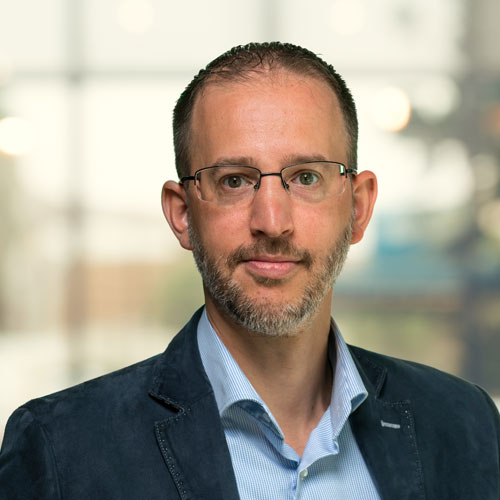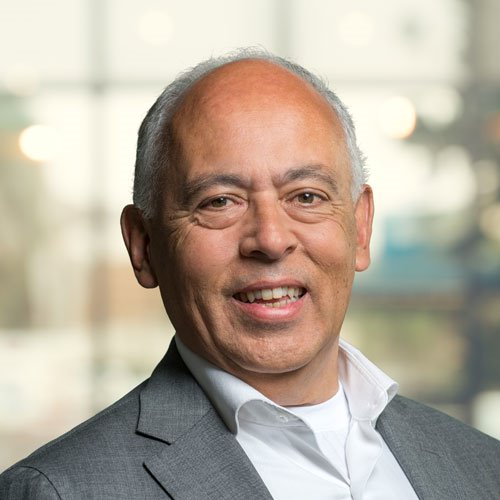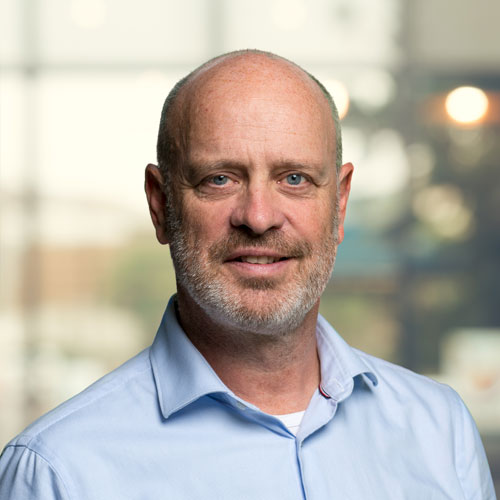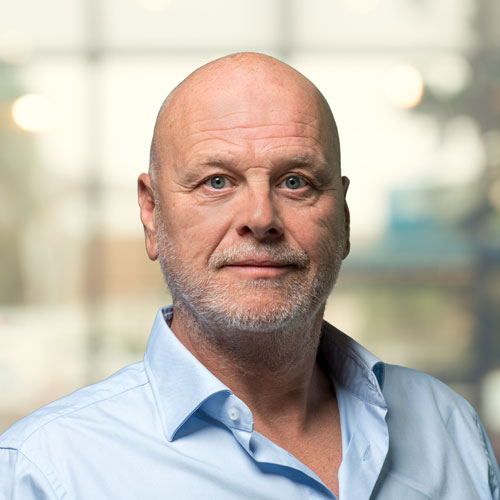Smart society brings digital community closer together
With 'smart society', we focus on smarter cooperation, the best infrastructure for new applications, and digitisation in line with our standards. That is how we stay connected. Even when we are far removed from one another. Discover the range of our activities.
Social XR connects digital worlds with reality
The COVID-19 pandemic forced more and more people around the world to stay indoors. They had to face challenges such as working, studying, socialising and buying services remotely. We are therefore looking forward to the first large-scale communication service that connects reality with virtuality in an easily accessible way.
Our XR software makes it possible to 'cut out' real-time 180-degree video images of people in another location and 'paste' or project them in 3D over the reality on site. This makes ‘being together remotely’ possible, as you have a more intense experience of the other person being in the same room with you. This is one solution to many of the problems associated with COVID-19. But also, for example, to protect the availability of scarce services in sectors such as smart or other industry and healthcare.
We further develop the technology for specific market applications. But widespread acceptance does not simply happen by itself. Moreover, it raises the question of how the government will ensure that these developments do not violate the privacy of citizens. These issues are closely related, and they require an integrated approach that our expertise and experience can help with.
This video has been edited to show you what we see when imagining the future. In the TNO test environment, 'Being together remotely' is currently a working concept. But a practical consumer version with the image quality shown in the video is still in the future.
Ground breaking XR technology for a smart society
Find out how we can tackle societal challenges with social XR.
Dutch XR innovation demands accelerated time to market
The overwhelming potential of XR applications for the business sector also offers unprecedented opportunities for sectors including media and entertainment, healthcare and mobility. Imagine being able to actually experience the Eurovision Song Contest from your living room. Or a leading specialist being able to perform knee surgery on a patient located in a different country.
The pressure to develop and bring new XR applications to market is enormous, the competition is fierce. In order to claim a share in this highly dynamic market quickly, capability and a fast time to market are vital.
In our Medialab, we are working on a generic open source XR development platform for social and shared experiences. This makes many scenarios possible, and greatly shortens the time to market for start-up and scale-up businesses. This will accelerate many new possibilities based on XR technology.
The rise of social VR technology
We work with organisations across a wide range of sectors to develop new XR applications. Find out how this will help your organisation move forward.
There is an exponentially growing demand worldwide for innovative applications that involve remote social interaction. Towards platforms that allow our real and virtual worlds to merge seamlessly in a highly intuitive way, creating an Extended Reality (XR). This greatly enhances remote collaboration and conferencing. And this XR technology also offers unprecedented opportunities for the media and entertainment, healthcare and mobility sectors.
Our digital infrastructure in the Netherlands is one of the most advanced in the world. And that offers great advantages and opportunities. The potential of XR applications is staggering. And the playing field of developers is constantly evolving. We are looking forward to the first large-scale communication service that manages to connect reality and virtuality in an accessible way. It is important for providers of large-scale communication services to claim their share as quickly as possible in order to remain relevant.
The pressure on developing and bringing to market new XR applications is enormous. If we in the Netherlands and Europe want to keep up with this rapid development, it will require close cooperation between consumer service providers, platform developers and digital infrastructure providers.
Choose us as your independent partner to significantly accelerate the essential time to market period for XR applications. We also have in-house specialists who will assist in finding the best project format, approach and partners for this type of complex innovation process. We work with organisations in a wide range of sectors on the development of new XR applications. These include healthcare, media and entertainment, communications and mobility.
The best infrastructure for new applications
In order to provide a real chance of accelerated momentum towards a smart society, an upgrade of the digital infrastructure is essential. Our digital infrastructure in the Netherlands is one of the most advanced in the world. But these new technologies demand a lot more from the existing digital infrastructure. Also, they will only become commonplace if they work accurately, cheaply and without too much equipment on a large scale. And be available everywhere.
That is why we are working hard to engage in a close cooperation between consumer service providers, platform developers and digital infrastructure providers. Only then can we in the Netherlands and Europe keep up with this rapid development.
New applications call for 'six-lane digital highway’
Find out how we are helping to prepare the Dutch digital highways for the services of tomorrow.
New technologies, for example social XR, demand a lot more from the existing digital infrastructure, and will only become commonplace if they work accurately, cheaply and without too much equipment on a large scale and are available everywhere. If we want the Dutch digital highways to remain the vital arteries for tomorrow's digital services, we must innovate more and faster within our digital infrastructure.
We are working hard on innovations for an optimally functioning digital infrastructure, where demanding applications work error-free alongside all the other applications on the same network. In our test facilities we have network and ICT chains. We use these chains to test various innovations, applications and scenarios.
We are busy developing network slicing that allows service providers to easily deliver network functions tailored to specific industries or customers. Dividing mobile networks virtually into 'slices' creates an individual and unique network with all the associated benefits: less complexity, more individual control and flexibility, and guaranteed customised performance for the customer.
An advanced, flexible digital infrastructure will succeed only if we connect the existing digital networks and platforms and make them variably deployable. Examples include Clouds, Edge Computing, Data Centres, and so on. These are complex processes in which our service providers, network providers, platform providers and cloud services must cooperate fully, and in so doing, they will be able to strengthen their position and seize economic opportunities.
In such cooperation, we pull together with service providers from all sectors, such as telecoms, healthcare, business and agriculture. We also involve public authorities and industry. Finding the best project format, approach and partners for this type of complex innovation project is a skill in itself. That is why at TNO we work with Innovation Orchestrators.
Digitisation according to our standards
All developments within smart society affect our society. The COVID-19 crisis made it clear that, for a manageable Dutch smart society, it is vital that we invest more in ICT technologies such as artificial intelligence (AI), quantum technology and federated cloud services. So that remote working, remote care, remote education and less travel can further evolve.
It is ICT that is uniquely able to assume this cross-sectoral, international and innovative role. Digitisation makes it possible for the government to listen to dissenting voices in society when they unite online. And it facilitates organising and signalling to achieve real social impact.
A smart public authority invests in digitisation for the future
Find out how our public authorities can take a guiding role in the digitisation of society. To prepare our society more effectively for future challenges.
How do you use new data sources and technological developments such as artificial intelligence (AI) to gain new insights and to better anticipate social developments? We have developed a methodology for policy makers: the Policy Lab. Using this methodology, we help the government to explore strategies and to investigate what the digitisation of society means for a policy.
Naturally, you want data to be stored safely and only temporarily. At present, the dependence on big data stored in non-European servers is too high. This is why, together with a large number of knowledge partners, we have joined the European cloud platform Gaia-X.
Gaia-X itself does not develop cloud infrastructures, but draws up 'ethical' guidelines, policies and technical documentation that enable businesses in the smart society to exchange and store data subject to European rules. This is the only way to make it possible for responsible data analytics to be stored on local platforms where the data is stored only temporarily.
Our public authorities can now assume a guiding role and take action to prepare our society even better for the challenges ahead, using ICT as the key technology. The use of data and algorithms for social applications is expected to increase. We can only build on this if we have the assurance of the right information and expertise, which is reliable and viewed in its proper context.
We work on innovative ICT solutions that both improve analyses and enable their responsible use. With Big (Open) Data in combination with Artificial Intelligence (AI), we can, for example, make smart cross-links. At all these levels, we work as a knowledge partner on the requisite innovations, often in public-private partnerships.





